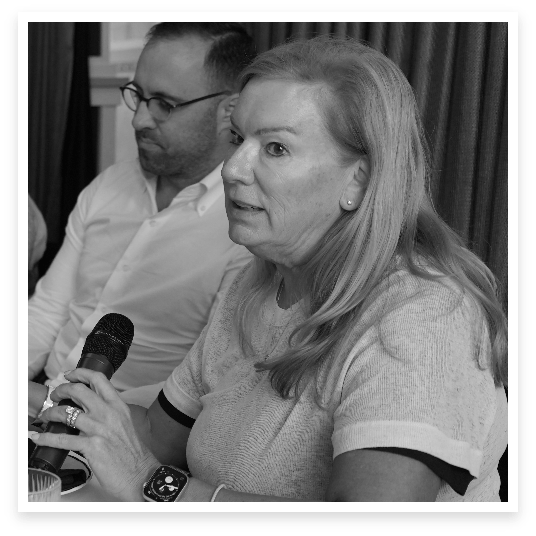
By:

“The greatest achievement of technology is not how it changes life, but how it improves it,” according to Satya Nadella, CEO of Microsoft. In the home loan arena, technology has been slow to take off, but things are now escalating at a rampant pace.
Many lenders have been investing heavily in their technology stacks to accelerate the mortgage process, with some, such as Bendigo Bank, prioritising this innovation within the broker space.
In late May, The Adviser hosted an Elite Broker roundtable, partnered by Bendigo Bank Broker, to discover what brokers most want from a lending partner and how banks can rise to the occasion.
Led by Darren Kasehagen, general manager third party banking, and Natalie Sheehan, head of broker and strategic partnerships at Bendigo Bank, the roundtable highlighted the bank’s commitment to technological advancement and collaboration with brokers.

Darren Kasehagen
General manager of third party banking, Bendigo Bank

Natalie Sheehan
Head of broker and strategic partnerships, Bendigo Bank
Bendigo Bank’s journey of transformation began with the merger of Adelaide Bank and Bendigo Bank in 2007. However, the integration of their core banking platforms wasn’t immediate. It took a strategic decision five years ago to invest to redesign and rebuild their lending platform, merging the core banking systems. This initiative aimed to streamline operations from eight core banking platforms to just one, significantly enhancing efficiency and service delivery.
Speaking at the luncheon, Kasehagen outlined how the bank has been innovating to accelerate the loan writing journey for brokers.
“Five years ago, we actually decided to commit to a program to completely redesign and rebuild our lending platform, but also to merge the core banking systems. We are now in the last six months of this work. The bank’s gone from eight core banking platforms down to now just two left (one being the Bendigo Bank target state and our Adelaide bank core banking system),” he said.
“We progressively rolled out a new lending platform under the Bendigo Bank brand from November of 2023 through to August 2024. And AFG, Connective and Lendi will have access to that new lending platform from mid-June [for Bendigo-Bank funded white label products], which we’re super excited about.
“Five years ago, we actually decided to commit to a program to completely redesign and rebuild our lending platform, but also to merge the core banking systems. We are now in the last six months of this work.”
- Darren Kasehagen, Bendigo Bank.
“In late October, all of our collective customers will move off the old products –onto the brand new product set that is the new Bendigo Bank mortgage offering.”
Kasehagen emphasised that the bank had prioritised the broker channel in this rollout, acknowledging the importance of this channel along with the aging technology stack that had supported originations historically.
He explained that this prioritisation reflects Bendigo Bank’s understanding of the pivotal role brokers play in today's mortgage ecosystem where a growing number of consumers are choosing to seek out a broker to help with their home loan needs
Sheehan echoed this sentiment, highlighting the bank’s motto, “Better for brokers”, which signifies its dedication to improving broker relationships. She noted the dramatic improvement in its “time to yes” metric and said: "Previously it could take two and a half days to get a conditional approval. We're now at around six minutes for a conditional approval, which for us is just a game changer."
“For formal approvals, we've had one that was 37 minutes. So it is a new world as far as we’re concerned.”
The Bendigo Bank leaders added that the bank was keen to know what was important for brokers. Sheehan commented that it was “really important” for the bank to know what brokers most want from lenders “as far as the relationship, the product, and what your clients are looking for”.
"Previously it could take two and a half days to get a conditional approval. We're now at around six minutes for a conditional approval, which for us is just a game changer."
- Natalie Sheehan, Bendigo Bank.

For many brokers, the current lending environment is ripe for disruption. The roundtable discussion brought to light the challenges faced by brokers when accessing lending platforms in the current market.
Nicole Cannon, founder and director of Pink Finance, pointed out the complexities of document collection and compliance, which, despite technological advancements, remain time-consuming. Cannon’s expansion journey, having doubled her business size in three months, illustrates the dynamic nature of the mortgage broking industry and the need for adaptable systems and processes.
“My biggest challenge is doing that journey of stepping away and growing that team… being able to speak to a processor or the parabroking team will then take that pressure off the broker if you do have a team that actually manages the workflow,” she explained.
“Even the two-factor multi authentication.. if a team is trying to log on and then they need a code [but I’m in an appointment],… there’s a disconnect with this technology at the moment.”
Darren Little, general manager of lending and executive director at Viridian Financial group, added: “It’s very difficult with a couple of the major banks at the moment that are still wanting wet signatures on forms and all sorts of things just to make it difficult to get a client outcome.
“At the end of the day, we’re trying to just work with them to actually maintain their client relationships and we want to be efficient, we want to be able to use online portals.”
Indeed, Little revealed that the brokerage employed members of staff whose job was to call the banks and remain on hold, but lending technology was starting to catch up.
Christian Stevens, CEO of Flint, also shared insights from his transition from a broker to running a team and the challenges brokers face when onboarding new brokers to lenders.
“The biggest issues we’re having is just consistency across the team accreditation-wise. A lot of our brokers that have come across have been from [other] aggregators are having to get re-accredited. That process alone is an absolute nightmare. So I think a bit more consistency across the industry would be good,” Stevens said.
“At the end of the day, we’re trying to just work with [lenders] to actually maintain their cilent relationships and we want to be efficient. We want to be able to use online portals.”
- Darren Little, Smartmove - part of Viridian Financial Group

The conversation also touched on the importance of direct communication with credit teams. Leeanne Scott, owner manager at Mortgage Choice North Sydney/Lavender Bay, has been using Bendigo Bank Broker for several months and praised Bendigo’s approach, which allows assessors to communicate directly with brokers.
This direct line of communication is invaluable, enabling brokers to provide additional context to applications and improve the likelihood of approval, she said.
“Some of the things that Bendigo are doing really well is their speed to pick up an application, their speed to yes. And also their ability to have the assessor talk to me directly. That’s a really big one in my world; being able to talk to the person making a decision and to be able to say: ‘I know the backstory, it’s not just what you can see on the paper’… that makes a big difference in terms of being able to get the right answer,” she said.
Tom Hawley, director at Azura Financial, and Greg Bloom, a broker at 1st Street Financial, both stressed the importance of trust and consistency in lender-broker relationships. They noted that access to credit teams and consistent service are crucial for brokers when selecting lenders for their clients. The ability to workshop applications and receive commitments upfront can significantly enhance the broker’s ability to provide timely and accurate advice to clients.
Bloom commented: “Access to internal credit teams is critical. If you’re seeing vanilla deals, your BDM is pretty good to cover off. A good experienced BDM who returns phone calls within a couple of hours is gold. But I do think though that some of the banks that don’t maybe have the direct access to credit… We want someone who’s going to put their stamp on it and say, I’ve seen this being done, I’m experienced, I know what I’m doing, I’ll support this deal if we have any issues.”
Hawley added: “One area that could be reduced is the amount of documents that need to be signed in terms of settling the actual loan and even application documents.”
The future of the mortgage broking industry is undoubtedly intertwined with technological advancements. Theo Chambers, CEO of Shore Financial, pointed out the industry’s lag in adopting modern consumer behaviour technologies. He stressed the need for aggregators to enhance their technological offerings to keep pace with other industries and with the technology that lenders have at their fingertips.
“We actually have some pretty redundant technology across the whole industry and we are really falling behind as an industry as a whole... because of limitations with aggregator APIs and whatnot, they don’t give full data sets that no one really controls their data in a data lake. It’s all with the aggregator. It’s putting such roadblocks on technological progression,” Chambers said.
“Some of the things that Bendigo are doing really well is their speed to pick up an application, their speed to yes. And also their ability to have the assessor talk to me directly.”
- Leeanne Scott, Mortgage Choice North Sydney/Lavender Bay
As Bendigo Bank continues its journey, the focus remains on collaboration, consistency, and leveraging technology to enhance broker relationships.
Kasehagen noted that artificial intelligence will soon be embedded into certain processes.
“We’re about to announce a new five-year strategy for the bank and AI will form part of that, as will growth in our broker channel,” he said.
Sheehan added that the lender had also built ‘virtual branches’ for broker clients to access if they need support setting up transaction accounts or opening other accounts.
The bank’s strategic investments and prioritisation of the broker channel demonstrate a clear understanding of the evolving needs of brokers and their clients. By fostering strong partnerships and maintaining open lines of communication, Bendigo Bank aims to position itself as a leader in the mortgage broking industry, providing brokers with the tools and support they need to succeed in a competitive market.

Tune in to the episode with Natalie Sheehan, In Focus: the digital lending revolution, here.
My biggest challenge is stepping away and growing that team… being able to speak to a processor or the parabroking team will then take that pressure off the broker if you do have a team that actually manages the workflow. So it is navigating the different communication channels. Even the two-factor authentication, if a team is trying to log on and then they go, “We need, we need the code.” There’s just a, there’s a disconnect with this technology at the moment.

Nicole Cannon
Founder and director, Pink Finance
Certainty. If an assessor calls you and then you just answer the questions and they go, “Right, no worries, we’re going to issue a formal.” That’s what we want. And the ability to be able to serve our customers via the lender platforms post-settlement. Or having that transparency being able to download statements and having that conversation so that when we do the reviews, we know exactly where they’re at, we’ve got that information, and we are their source of truth and value of then helping them make decisions either with that bank or for the future… The role is of the broker to maintain that relationship. I think if a bank can accept that and welcome that, it allows us to be that broker and to create that relationship and have that client be ours for life.
I think just doing the basics well. Consistency of credit, consistency of approvals, and easy process end-to-end, especially when they’re transitioning through a digital landscape. It needs to be easy. You’re going to sign one set of docs, you shouldn’t have to go back to the start every time you need to change something, or pick up the phone.
I don’t think you need to redesign anything, I think you just got to do the basics right and the rest should take care of itself.. Having to go to four different people at different levels to get the same outcome is just delusional. When you can, you should just put one price in and get that approved and proceed.

Christian Stevens
CEO, Flint
I think where you get the best value from a lender perspective as a broker is understanding that Bendigo is known for XYZ [niche] and you’ll get all that business. I think that would be the best value-add for brokers to understand what your three or four core niches are – outside of great rates and multiple offsets and everything else. What are you the best at? And I think you’ll naturally find that you’ll get an enormous amount of business from brokers if you do that well consistently.
“Having to go to four different people at different levels to get the same outcome is just delusional. When you can, you should just put one price in and get that approved and proceed”
Good people build any business. Good support as a BDM is just so crucial and it’s amazing how some of the bigger banks with huge amounts of resources are putting some inexperienced BDMs in front of you who give you incorrect advice that you act upon. The consequences of that are very damaging. That means we won’t support the bank because they don’t have faith in their point of contact. It’s really crucial. It’s simple stuff, but it works. So putting good BDMs in the roles to support brokers, good assessors, that actually works through the deal with you, rather than just flick you an email for an MRI… Having people in the organisation that actually generally care about the outcome of the transaction.
Something as simple as a credit line where you can get a reference number for a policy that you verify that then gets quoted in the application would also be very helpful, so it’s black and white. And something that used to be more common that’s not happening as much these days is the preferential status for brokers where you can actually measure them on quality submissions and then reward them accordingly.

Theo Chambers
CEO, Shore Financial
It’s about a level playing field. For me, it’s about knowing that when I’m sitting in front of a client or talking to that client and then they walk into the branch down the road, the story is absolutely exactly the same… I want to know when I quote something to a client, I’m not going to be completely undermined by the local branch. Absolute channel conflict. It is so alive and well today, it is absolutely rife.
Across the end-to-end proposition, I want total visibility. It’s having the relationship with the bank and knowing that the respect is there that you’re going to look after the client. And that means pricing, that means that when it is time to leave, it’s a smooth discharge process. It’s about doing top-ups, it’s about everything on that entire journey.

Leeanne Scott
Owner manager, Mortgage Choice North Sydney/Lavender Bay
For most clients, price is probably up there first, then policy, then service. And we are part of that service component. We can’t influence price or policy. So obviously our objective is to find the lenders that will give our clients the best prices with the best service.
My preference is not to write business at 40 different lenders. Mine is to have a handful that can do it really well. So, why aren’t banks offering us preferential pricing, just matching out what everyone else has? We know that the service is great, just match us on price here. If we’re a good business, you can see our books and our books have grown. It makes it easy for us to sell [that lender] to our clients because we know we’re ticking all the compliance boxes and it’s genuinely in their best interests.

Greg Bloom
Broker, 1st Street Financial
It’s about having that trusted relationship and it is about being able to pick up the phone, whether it be a credit assessor or whatever. We don’t need a marketing brochure, we don’t need a flyer, we just need access to good people with good systems and the ability to actually genuinely partner.
We also genuinely want that access [via broker portals]. We don’t want to sit on the phones, we don’t want to ring a BDM. We actually want to have that access at our fingertips, so we can genuinely add value to our clients and we can actually see all the deals in our business moving through… if we can actually see and feel those files moving easily, it makes a big difference.
What we look for is niches. Generally, once we start with a bank with niches, we try them out. If they start to work, then we do more and more business there as we build confidence in them as a bank. Multiple offsets and all these things, that is a minimum requirement now for a client… this is not next or extra and this is base level stuff. If the niches are there or if your time to yes is competitive, that’s what we’re looking for.

Darren Little
GM, Lending, Smartmove – part of Viridian Financial Group
“What we look for is niches. Generally, once we start with a bank with niches, we try them out. If they start to work, then we do more and more business there as we build confidence in them as a bank”
“What we look for is niches. Generally, once we start with a bank with niches, we try them out. If they start to work, then we do more and more business there as we build confidence in them as a bank”
Strong relationships are built with lenders and brokers with more phone contact from assessors. When you lodge an application, you want to know when’s it picked up? Does it look okay? What’s the process? What’s next?
I feel like some lenders have got it right and some lenders have got it wrong and a lot can be learned from some of the lenders that have streamlined what is required upfront.
The lenders we have developed strong relationships with – and end up doing a lot of business with – are the lenders who have given us direct access to credit teams… That is the difference between a bank that maybe doesn’t do a lot of volume with a brokerage to one that does do a lot of volume with us. Being able to get some things worked on often and committed to upfront is really important for us because there’s a lot of effort towards an application and there’s nothing worse than lodging something and not knowing if you’re going to get a result.
As a broker, you’ve got, you know, 30/40/50 lenders and a lot of the time, for lenders like Bendigo breaking back into the market, it’s about being front of mind. So just simple marketing in our inbox, easy to digest, or maybe case studies about where you did something for someone, got something over the line, text messages, regular calls, office visits, all that sort of stuff. It goes a long way.

Tom Hawley
Director, Azura Financial
“The lenders who have given us direct access to credit teams… is the difference between a bank that maybe doesn’t do a lot of volume with a brokerage to one that does do a lot of volume with us”
“The lenders who have given us direct access to credit teams… is the difference between a bank that maybe doesn’t do a lot of volume with a brokerage to one that does do a lot of volume with us”

Darren Kasehagen
General manager of third party banking, Bendigo Bank

Natalie Sheehan
Head of broker and strategic partnerships, Bendigo Bank
